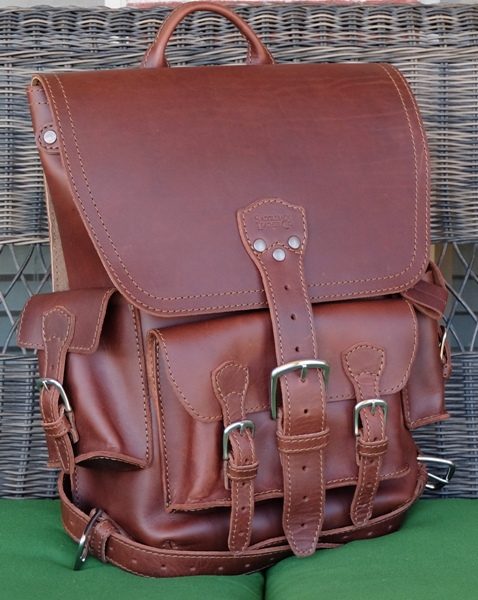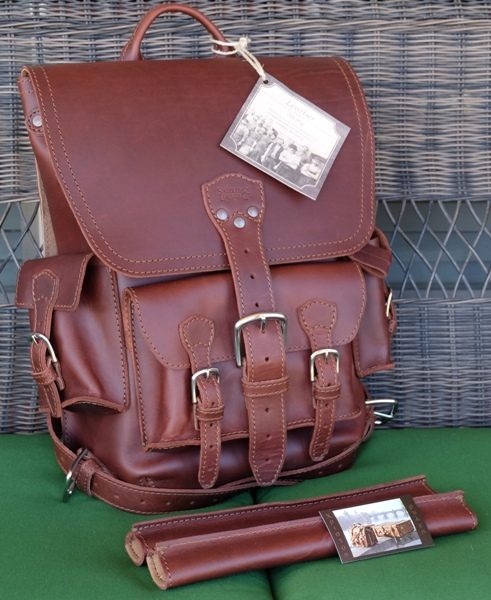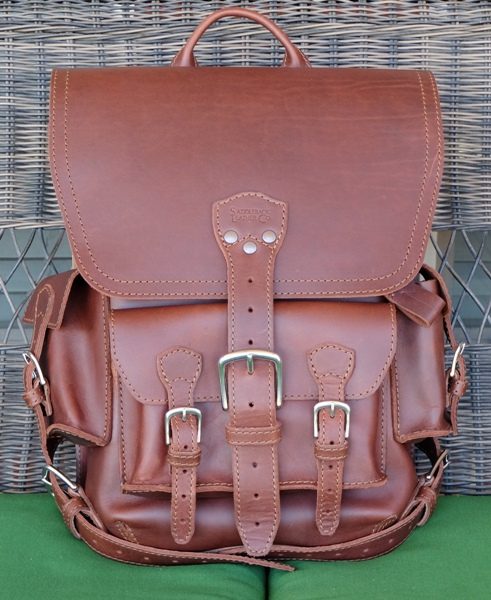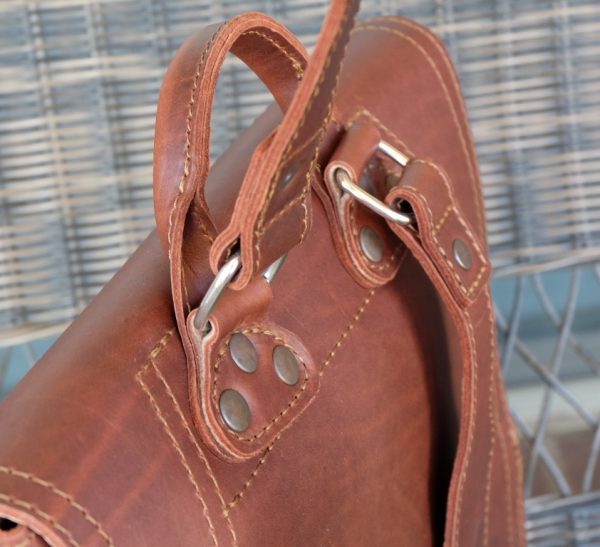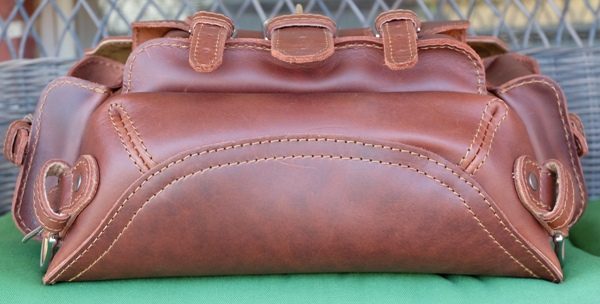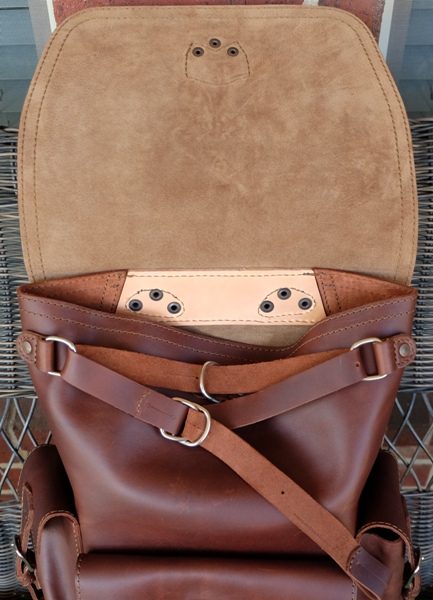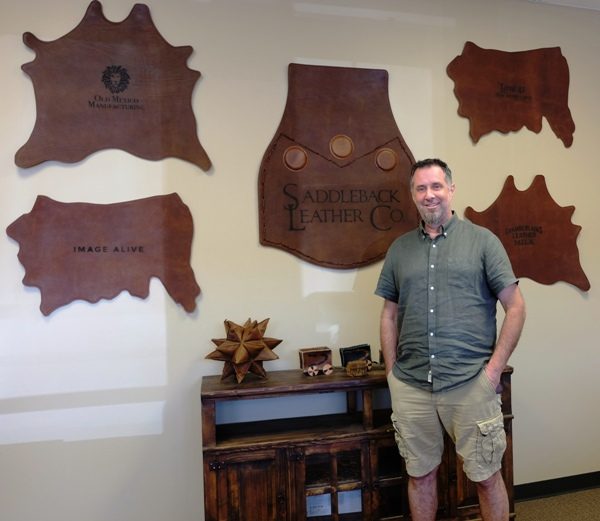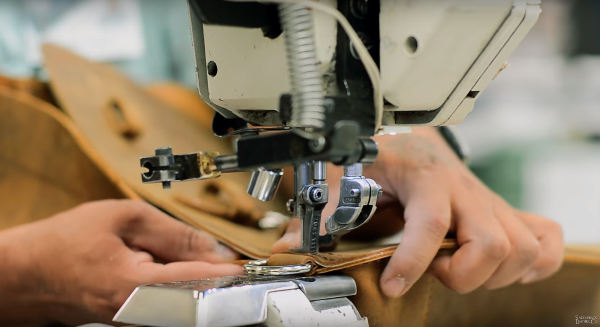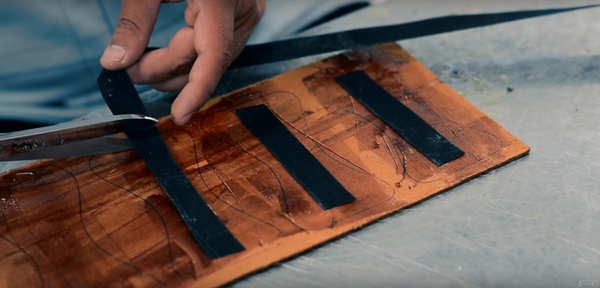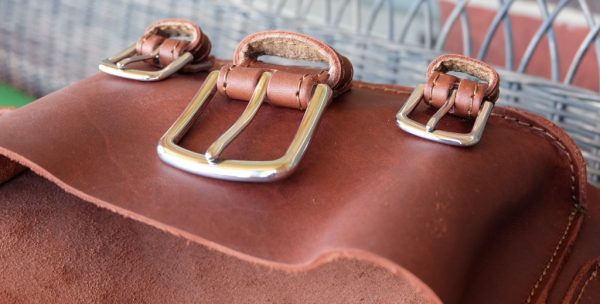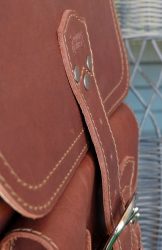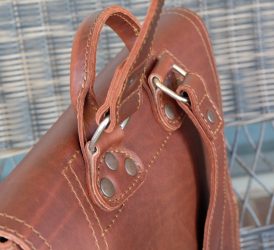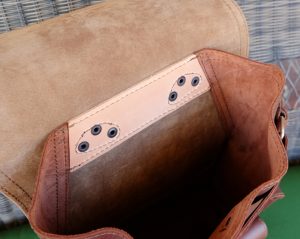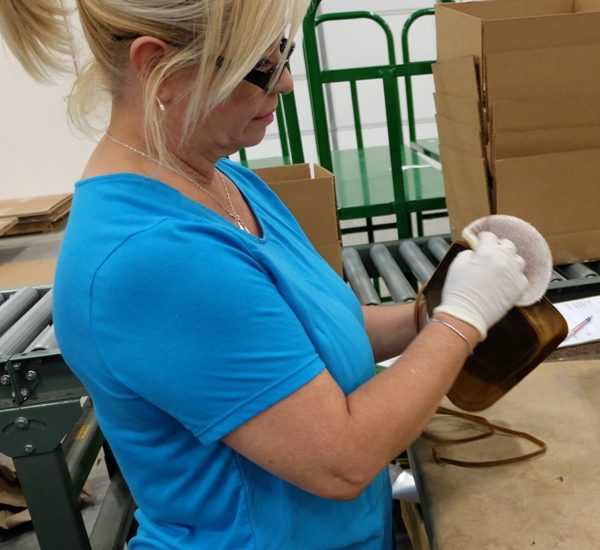I love backpacks. It is my preferred method for carrying around my teaching materials, but what I don’t like having to do is to continuously buy bags because they wear out. Enter the Saddleback Leather Co. and their line of leather backpacks. I was awarded the opportunity to review their Thin Front Pocket Backpack. This backpack puts other backpacks to shame. It’s heavy even when empty, but WOW, it’s beautiful and well made!
The Saddleback Leather Thin Front Pocket Backpack is more beautiful in person than in my photos. It came with two padded leather straps, a business card (Χριστος ρυλες is printed on the card along with Saddleback information), and an information card which states that they don’t make any effort to hide the scars and bug bites on the cowhide used in the bag.
Design
 The above photos were taken outdoors.
The above photos were taken outdoors. And these were taken indoors. You can see the differences in the appearance of the color of the backpack. Since I observe the backpack most often when it is indoors, the lower photographs seem to represent the color more accurately. I love the Chesnut color of this backpack. The backpack also comes in Tobacco (tan colored), Dark Coffee Brown, and Black. It smells wonderful too!
And these were taken indoors. You can see the differences in the appearance of the color of the backpack. Since I observe the backpack most often when it is indoors, the lower photographs seem to represent the color more accurately. I love the Chesnut color of this backpack. The backpack also comes in Tobacco (tan colored), Dark Coffee Brown, and Black. It smells wonderful too!
There is one main compartment, a front pocket, and two small side pockets on this backpack. The front of the backpack has three stainless steel buckles. The center buckle and center strap keep the main compartment of the backpack closed. The other two are used to keep the small front pocket closed – but in order to access the front pocket, you must unbuckle all three. Each of the side pockets has a one-buckle closure (also stainless steel). In fact, there are no zippers or snaps in this or any of Saddleback’s bags. They avoid using them in the designs of their bags because they are more prone to break than buckles.
There is also a handle at the top of the backpack to grab when you are on the go. In addition, it is important to note that when empty, the backpack weighs four pounds.
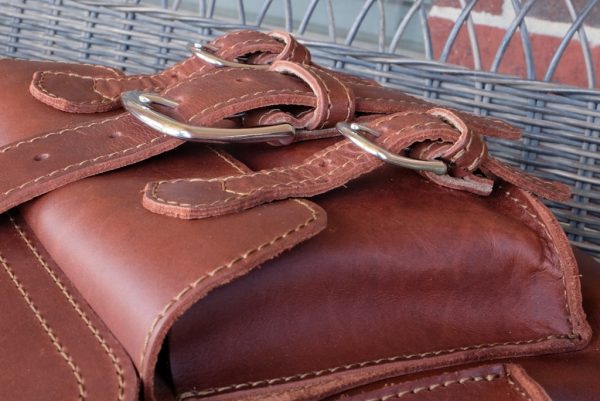 The entire backpack is made of very thick leather that measures about 2 – 2.2 mm. The straps (the shoulder straps and buckle straps) are made from two long pieces of leather sewn together, thus the straps end up being about 4 mm thick. Straps and belts of cheaper non-Saddleback products are made from several pieces of leather spliced together to make one belt.
The entire backpack is made of very thick leather that measures about 2 – 2.2 mm. The straps (the shoulder straps and buckle straps) are made from two long pieces of leather sewn together, thus the straps end up being about 4 mm thick. Straps and belts of cheaper non-Saddleback products are made from several pieces of leather spliced together to make one belt.
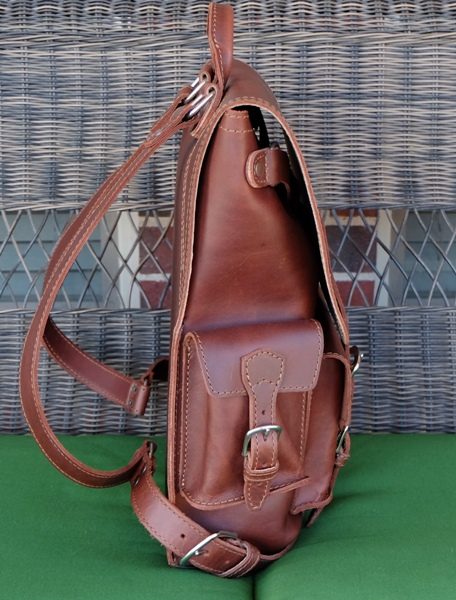 The straps of the Thin Front Pocket Backpack are adjustable using the two angled stainless steel buckles located on each side of the bottom of the backpack. The angle of the buckles is an important feature that ensures a comfortable fit so the straps do not cut into your body while wearing it.
The straps of the Thin Front Pocket Backpack are adjustable using the two angled stainless steel buckles located on each side of the bottom of the backpack. The angle of the buckles is an important feature that ensures a comfortable fit so the straps do not cut into your body while wearing it.
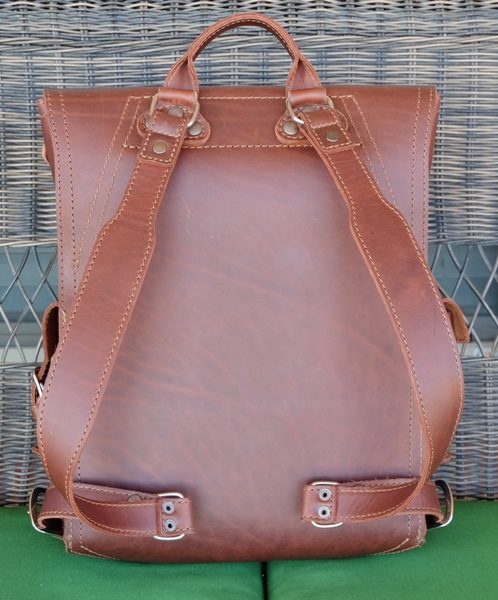 Not only are the handle and leather anchors for the shoulder straps sewn onto the backpack, but they are riveted as well.
Not only are the handle and leather anchors for the shoulder straps sewn onto the backpack, but they are riveted as well.
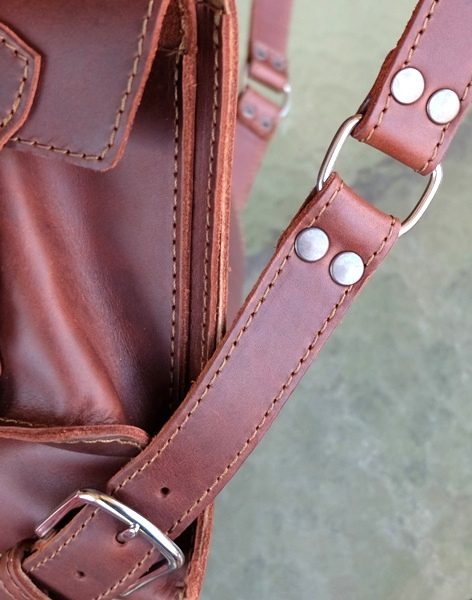 Metal D-rings are used to attach the shoulder straps to the leather anchors at the top of the backpack (the ends of the straps are folded over the D-rings and riveted as well) and to the buckle straps at the bottom as shown in the above photo.
Metal D-rings are used to attach the shoulder straps to the leather anchors at the top of the backpack (the ends of the straps are folded over the D-rings and riveted as well) and to the buckle straps at the bottom as shown in the above photo.
The bottom of the backpack shows the slight tapering of the bag from back to front with the widest point of the main compartment being toward the back. The leather anchors that hold the buckles for the shoulder straps are sewn and riveted onto the backpack. You’ll also notice that the bottom of the bag is double stitched.
Under the main compartment flap, there is a drawstring style utility strap (held in place with D-rings which are attached to leather anchors that are sewn and riveted onto the backpack). This strap is used to close the main compartment, thus ensuring that the contents are held securely inside the backpack. This also ensures that there are no exposed gaps that might let rain in when the flap is closed. 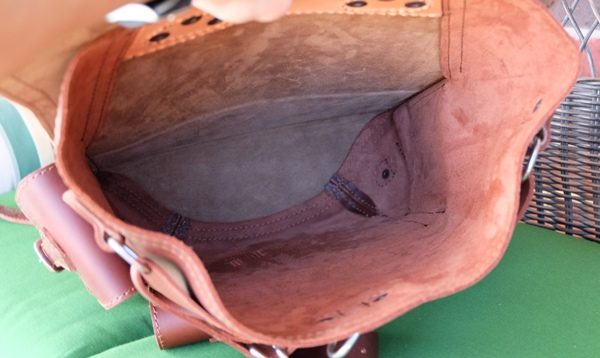
The main compartment interior dimensions are about 11″ wide x 3.5″ deep x 15.75″ high. The front and sides of the main compartment are not lined. The back and bottom of the main compartment are lined with pigskin, one of the toughest leathers (tensile strength) out there second only to kangaroo hide.
The lower back section of the backpack is padded with neoprene which really helps to keep your items from digging into your back.
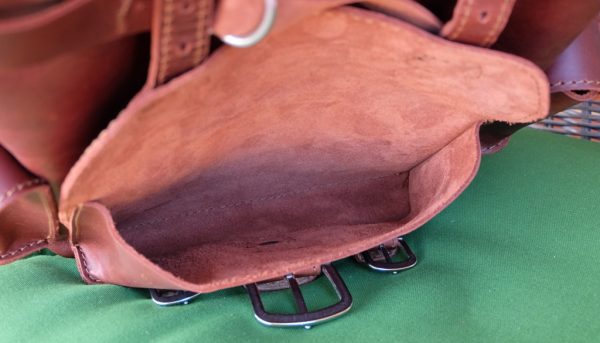 The front of the backpack contains a front pocket. It is approximately 7.5″ wide x 1.25″ deep x 5.5″ high. There is no lining inside the pocket.
The front of the backpack contains a front pocket. It is approximately 7.5″ wide x 1.25″ deep x 5.5″ high. There is no lining inside the pocket.
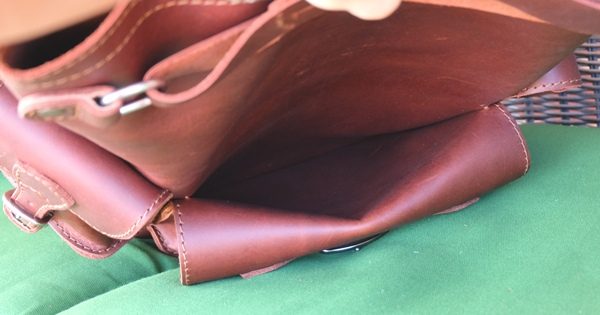 There is also a space behind the front pocket (a slot pocket) to slip things into for easy access (very nice design).
There is also a space behind the front pocket (a slot pocket) to slip things into for easy access (very nice design).
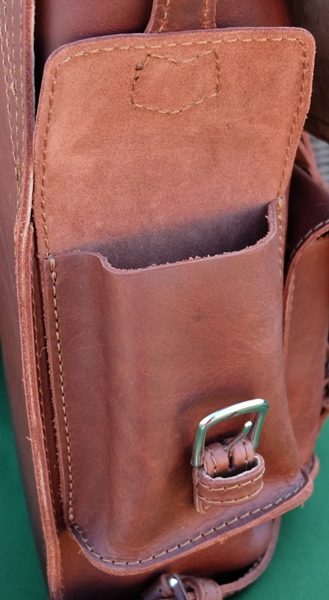 Each side of the backpack has a small side pocket measuring approximately 3.5″ wide x 1.25″ deep x 5″ high.
Each side of the backpack has a small side pocket measuring approximately 3.5″ wide x 1.25″ deep x 5″ high.
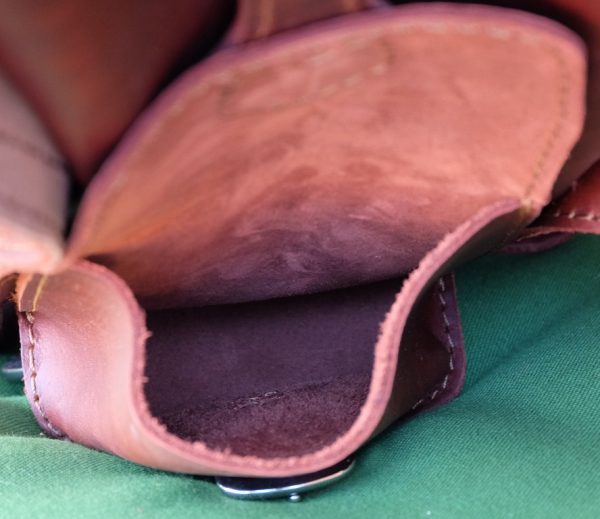 The pocket is also not lined as illustrated in the above photo. The buckle on each of the side pockets was difficult to unbuckle and re-buckle because of the stiffness of the leather strap. I’m sure, however, that the leather will become more flexible over time.
The pocket is also not lined as illustrated in the above photo. The buckle on each of the side pockets was difficult to unbuckle and re-buckle because of the stiffness of the leather strap. I’m sure, however, that the leather will become more flexible over time.
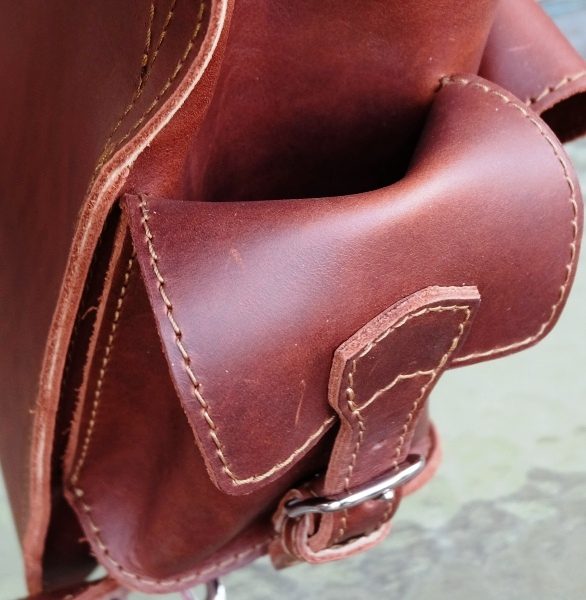 Just like the slot pocket behind the front pocket, there are slot pockets just behind the side pockets as well. The above photo also illustrates the thick thread used to assemble the entire backpack. Saddleback uses continuous filament polyester thread for its strength.
Just like the slot pocket behind the front pocket, there are slot pockets just behind the side pockets as well. The above photo also illustrates the thick thread used to assemble the entire backpack. Saddleback uses continuous filament polyester thread for its strength.
My Impressions
The Thin Front Pocket Backpack has “Thin” in its name because of the size of the main compartment and not because of the thickness of the leather used or that the front pocket is thin. I usually carry around more in my other backpack than this one will allow me to, but that just means that I either need to cut down on the number of items that I carry or purchase the larger Leather Front Pocket Backpack.
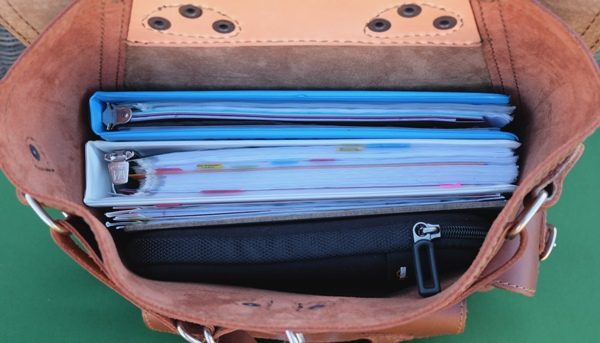 I was able to fit a 1/2″ binder, a 1″ binder, two pocket folders, a thin white board, and a portable Bluetooth keyboard (inside a neoprene case) in the main compartment. This backpack is not meant to carry a lot of items like the full-size Leather Front Pocket Backpack.
I was able to fit a 1/2″ binder, a 1″ binder, two pocket folders, a thin white board, and a portable Bluetooth keyboard (inside a neoprene case) in the main compartment. This backpack is not meant to carry a lot of items like the full-size Leather Front Pocket Backpack.
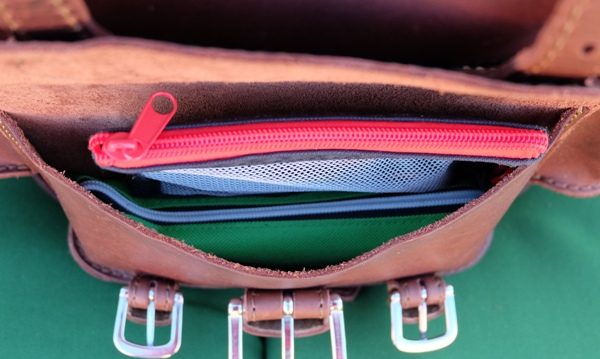 I was able to insert my pencil case and a small zipper pouch containing my post-it tabs in the front pocket. They fit snugly, but they fit! One thing to take note of is that it takes time to access the pockets and main compartment of the backpack because of the buckles, especially the front pocket which requires that you unfasten three buckles, not just one.
I was able to insert my pencil case and a small zipper pouch containing my post-it tabs in the front pocket. They fit snugly, but they fit! One thing to take note of is that it takes time to access the pockets and main compartment of the backpack because of the buckles, especially the front pocket which requires that you unfasten three buckles, not just one.
Unfortunately, the side pockets do not accommodate any of the water bottles that I have, thus I did not put anything in those pockets. However, the pocket is a good size to accommodate your wallet. My large Nexus 6 phone fits in this pocket but in order to close the pocket, I needed to use the last hole in the strap for the buckle.
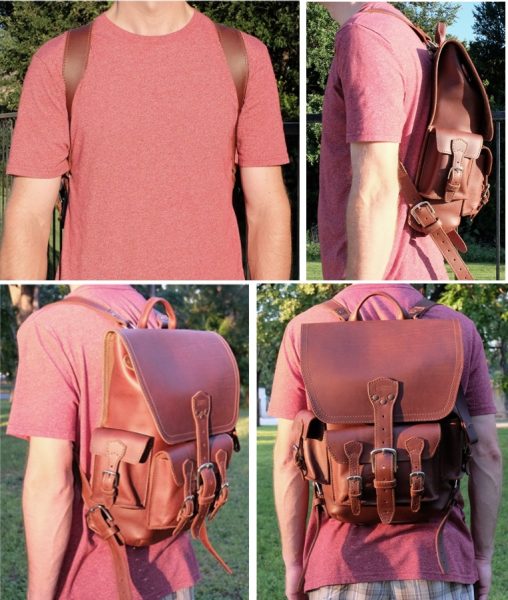 I found that the backpack was comfortable to wear after making the correct buckle adjustments (okay, so the above photos are not me, but I’m the “photographer” of the family; even so, the backpack fit both me and my husband well). I found that it was more comfortable to wear it without the padded leather straps that were sent with the bag so I left those off.
I found that the backpack was comfortable to wear after making the correct buckle adjustments (okay, so the above photos are not me, but I’m the “photographer” of the family; even so, the backpack fit both me and my husband well). I found that it was more comfortable to wear it without the padded leather straps that were sent with the bag so I left those off.
As I mentioned previously, when empty, the backpack weighs four pounds because of the thickness of the leather used to make it. When I filled it with the materials that I needed to carry, it then weighed 14.6 pounds which is a good weight for me since I sometimes carry another 15 pounds of materials around with me. Thus, I guess the weight really doesn’t bother me. It is important to note that, in general, I don’t carry my backpack around for long durations so I do not know how long this backpack would remain comfortable.
There’s no question about it, this backpack is going to last way beyond my years. It’s made using very thick leather, strong continuous filament polyester thread, and stainless steel hardware. All of the buckles are sewn and riveted onto the backpack. High-stress areas are riveted as well. Yep, it’s the cockroach of bags (in a good way) – it will survive when nothing else does. I didn’t do any crocodile testing like Dave Munson, the founder, and president of Saddleback Leather Co. According to the Saddleback website “The Quality Story – Chapter 3: How It’s Made“, in an effort to test the strength of his bag, he got a crocodile to latch onto it and thrash around (don’t worry, he had the bag on a pole). When he finally retrieved it he was hoping to see bite marks on the bag but it ended up having only a few scratches and scuffs.
There are those who feel that Saddleback products are too expensive (this backpack is $485.00), but if you continue reading the following information, I think you’ll quickly understand the basis for their pricing and that you are getting a top notch item when you purchase this or any other Saddleback product.
What goes into a Saddleback bag, what you are paying for, and why you can feel good about purchasing one
One thing that I have thoroughly enjoyed while working here at the Gadgeteer is all of the learning opportunities that I have had while investigating my review products. This time, in addition to my normal research, I was also able to tour the Saddleback Leather Co. office/repair shop/shipping area in Fort Worth, Texas thanks to Trent Funk, COO. He patiently guided me around the facility, introduced me to a few who work there, and answered all my questions. I also had the opportunity to meet Dave Munson (the above photo is one I took while on my tour). He too visited with me and answered my questions. He is such a fascinating guy!
In addition to what I learned on the tour, Mr. Munson provides a plethora of information on the Saddleback website about how Saddleback got started and all the wonderful stories that make up this modern day Indiana Jones and his company (seriously, he’s traveled the world: Bora Bora, Kenya, Australia, Scotland, Cayman Islands, Canada, Jamaica, Spain, Seychelles, Tanzania, Rwanda, Ireland, France, New Zealand and all over Mexico according to “The Saddleback Story“). He also provides a lot of information about how his products are made and why they stand out. So I watched several of his videos and read several of his posts and wanted to inform you of what you are getting when you purchase a Saddleback product. All of the following information came from the Saddleback website, “Craftsmanship“.
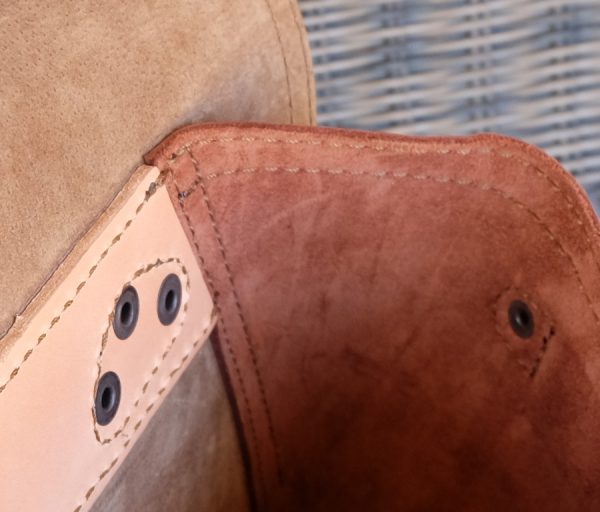 The Leather: This backpack is made entirely out of leather and very thick leather at that (~ 2 – 2.2 mm), as shown in the above photo of my backpack. This is why it weighs four pounds when empty. Mr. Munson’s products are made completely out of the highest grade of leather which is full grain leather. This is the uppermost and toughest layer of the hide (it is not made from the lesser grades of leather like top grain leather, genuine leather, or bonded leather). Beware, some businesses claim that their products are made from full grain leather when only a small part of each product is actually made using it.
The Leather: This backpack is made entirely out of leather and very thick leather at that (~ 2 – 2.2 mm), as shown in the above photo of my backpack. This is why it weighs four pounds when empty. Mr. Munson’s products are made completely out of the highest grade of leather which is full grain leather. This is the uppermost and toughest layer of the hide (it is not made from the lesser grades of leather like top grain leather, genuine leather, or bonded leather). Beware, some businesses claim that their products are made from full grain leather when only a small part of each product is actually made using it.
Mr. Munson obtains his leather from the second best-rated tannery in North and South America (LeFarc Tannery in Leon, Mexico). The leather he uses is properly and thoroughly tanned – not just on the surface of the leather, like some cheaper leather products you can buy. Properly tanned leather ensures that the leather is preserved throughout and will last a lifetime. If the tanning is properly done, the leather will not break down. Mr. Munson purchases this expensive high-quality leather to make his products which helps to explain the pricing of this backpack.
He also uses large pieces of leather when making the bags which means fewer seams and thus increased strength. Cheaper leather products are made with many pieces of leather (they use scraps of leather to construct their products) and have many seams (seams tear) in order to cut costs.
The Thread: He uses thick continuous filament (marine-grade) polyester thread – the type used in sails of ships, parachutes, or work boots. It is the best thread to use when subjected to sunlight – it is UV resistant (not UV proof). It is much more expensive than nylon thread and cotton thread is the cheapest.
When a company makes a thread out of cotton, for instance, the short cotton fibers need to be joined together creating many weak points along the length of the thread. Thus, you want to use the longest fibers possible to make the thread stronger. Since polyester is a manmade material, you can make a long continuous filament that is wound around several other long continuous polyester filaments to make a really strong thread which is what Mr. Munson uses.
Quality equipment, stitching, and stitch length: The above image is a screenshot from the Saddleback Leather video, “How to Knockoff a [Saddleback] Bag“. What ensures the high-quality stitching of a Saddleback bag is the $12,000 – $14,000 sewing machines that they use. These sewing machines have a guide, a clutch, larger bobbins, etc. to create the high-quality construction of Saddleback bags.
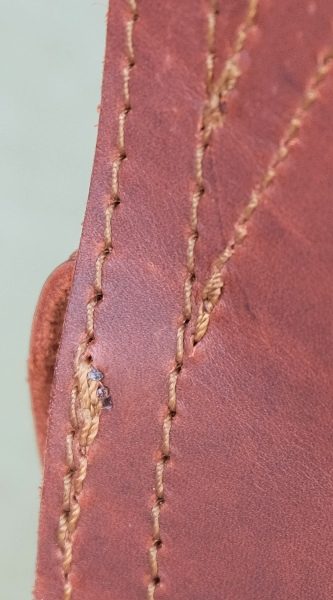 It is also important to consider the stitching and the stitch length. Seams are a necessary evil (unless you want your item to be shaped like a cow). Sewing machines perforate the leather and the more holes there are the weaker it is. Saddleback uses five stitches per inch which is a really good balance between the stitch length and leather for strength considerations. (Wow! I did not think about this and now that I know, I am revising my stitch length preferences). When Saddleback assembles a leather bag, one stitch is used to sew in the lining and another is used to sew the leather together so that in total you end up with a double stitch. At the end of the stitching they go back over the last few stitches then forward again, then they burn the end of the thread as shown in the photo above of my backpack’s stitching.
It is also important to consider the stitching and the stitch length. Seams are a necessary evil (unless you want your item to be shaped like a cow). Sewing machines perforate the leather and the more holes there are the weaker it is. Saddleback uses five stitches per inch which is a really good balance between the stitch length and leather for strength considerations. (Wow! I did not think about this and now that I know, I am revising my stitch length preferences). When Saddleback assembles a leather bag, one stitch is used to sew in the lining and another is used to sew the leather together so that in total you end up with a double stitch. At the end of the stitching they go back over the last few stitches then forward again, then they burn the end of the thread as shown in the photo above of my backpack’s stitching.
Note: When purchasing non-Saddleback products, you’ll want to watch out for cheap thin thread (bobbin thread) being used on the underside of a sewn product.
Leather reinforced with nylon strips to add strength and eliminate stretching: The above image is also a screenshot from the Saddleback Leather video, “How to Knockoff a [Saddleback] Bag“. Nylon strips (which don’t stretch) are inserted into leather pieces on the bag that are subjected to high stress to prevent the leather from stretching over time (e.g. the center belt and main center buckle, handle and leather anchors for the shoulder straps, leather D-ring areas and in the side pieces where the straps attach to the bag, etc.). Mr. Munson learned this trick from a German leather craftsman.
Type 316 stainless steel hardware: Saddleback uses hardware made from type 316 stainless steel. The most common stainless steels used today are types 304 and 316. 316 stainless steel contains molybdenum. According to the International Stainless Steel Forum (ISSF) and Atlas Steels, “The molybdenum gives 316 better overall corrosion resistant properties than Grade 304, particularly higher resistance to pitting and crevice corrosion in chloride [salt] environments.” It is important to note that cheaper leather products will often use hardware that is nickel or chrome plated which will eventually wear off.
The above photos also illustrate how the undersides of the loops just below the buckles on the Thin Front Pocket Backpack are lined with pigskin, perhaps to add strength.
Rivets: Rivets are placed in areas of stress to reinforce the bag and give it a great deal more strength. You can see from the above photos the rivets used in the main buckle strap and the handle and shoulder strap areas of the backpack. They are also used to attach the buckles to the backpack and the drawstring style utility strap located at the top of the main compartment of the backpack.
Two kinds of rivets are used in Saddleback products: a rounded top rivet used in flexible leather areas (e.g. near a flap because the rounded top metal rivet won’t cut into the leather) and a washer rivet where the washer fits over a piece metal and is hammered down into place (this is used in really high-stress areas but not in flexible leather areas because this metal rivet would cut into the leather).
Leather as an insulator to protect your gadgets: Because leather is a good insulator, the thick leather of Saddleback bags is good at protecting your electronic gadgets from the effects of fluctuating outdoor temperatures. Exposure to a variety of temperatures can cause the metal in your gadgets to expand or contract at different rates than the plastic or glass in those devices thus causing the damage. However, there is no padding inside the backpack so you will have to protect your gadgets from impact using other means.
Saddleback employees: Saddleback Leather also trains and pays their employees well to eliminate high employee turnover rates. They also make efforts to cater to an individual’s talents and gifts and encourage creativity so that employees will experience job satisfaction – a sense of a job well done as well as feeling like they have contributed something of great value to their customers.
While touring the Saddleback Fort Worth office, everyone I met was warm and welcoming. Abram Wronko, the Oldbull Shipping (OBS) Manager, took me through the process of receiving the Saddleback items from their manufacturing facility in Leon, Mexico to shipping them worldwide. The above photo shows one of the employees ensuring that the product that is being shipped is looking its best. In addition to the Fort Worth facility receiving and shipping Saddleback products, this office is also a place where they design new items, create prototypes, and repair any products that might need it (do any need repairs?). I did not get the opportunity to observe any repair work because the person responsible for repairs was not in the office that day.
Cooperation with other companies and giving to non-profit organizations: I also found out on my tour that Saddleback works closely with other companies that coexist within the Fort Worth office, companies like Love 41 (women’s leather bags/accessories; created by Suzette Munson, Dave’s wife; 100% of the profits of Love 41 go to non-profit organizations like Africa New Life Ministries according to “The Love 41 Story“), Chamberlain’s Leather Milk (leather care products created by Patricia Chamberlain), and Image Alive (a photography studio that takes photos of Saddleback products and other companies’ products). It’s inspiring to see such cooperation, which is made possible because each company has the common goal of making high-quality products or providing high-quality services.
Saddleback also has a heart for people all over the world. They give their time and money to help many who need it. A lot of their profits are donated to financially accountable non-profit organizations like Africa New Life Ministries and the Juvenile Diabetes Research Foundation (Mr. Munson’s niece is battling this) – see “Dave’s Links” for more information. In addition, Mr. Munson also appears to enjoy visiting with anyone and everyone. “Relationships are where it’s at.” – Dave (from “The Saddleback Story“).
Final Thoughts
Having learned about how Saddleback products are made and knowing that they use top quality materials really makes me feel like the Thin Front Pocket Backpack is well worth the $485. It is made of very thick full grain leather (~ 2 – 2.2 mm) and partially lined with pigskin to strengthen the backpack. The buckles are made of corrosion resistant type 316 stainless steel (not chrome or nickel plated metals), all of which are sewn and riveted onto the backpack. The bag is also constructed using marine-grade continuous filament polyester thread. Anywhere where the leather might stretch is reinforced with nylon strips to prevent such stretching. I also love the Chesnut color and the smell of the backpack. The fit of the backpack was incredible too. It rested flat against my back when wearing it. I was surprised about that but it just goes to show you what is possible when a lot of thought is put into a well-designed backpack.
Even though the backpack is four pounds when empty and 14.6 pounds when filled with my teaching items, I’m quite used to carrying around very heavy backpacks so this did not matter very much to me. I also noticed that retrieving items from any of the pockets took a little time because of the buckles; however, buckles won’t break like zippers. The backpack even has a 100 year warranty. So, there is no question that the Thin Front Pocket Backpack is well made and if you don’t need to carry a lot on a daily basis (it is thinner than the full-size Leather Front Pocket Backpack) and you use a backpack all the time, then it is well worth the money; the only question is, is it your style?
Source: The sample used in this review was provided by Saddleback Leather Co. Please visit their website for more information or to purchase a Thin Front Pocket Backpack. You may also purchase one through Amazon.
Product Information
| Price: | $485.00 |
| Manufacturer: | Saddleback Leather Co. |
| Retailer: | Amazon |
| Pros: |
|
| Cons: |
|

